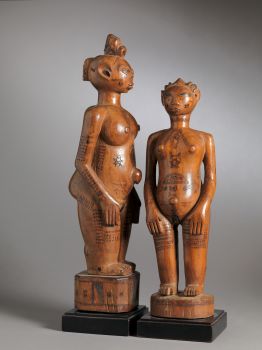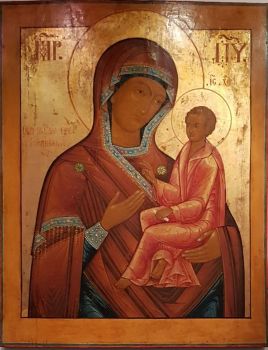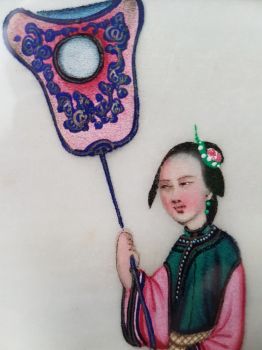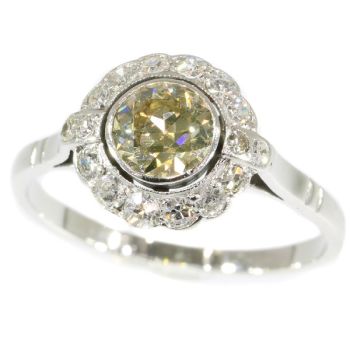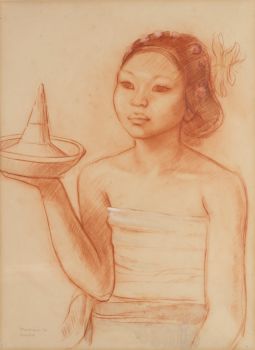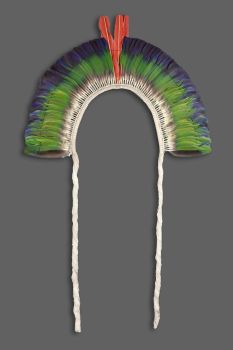UMA PEQUENA SAWASA JAPONESA 'FORMA DE PÊSSEGO' COPO CRUCÍVEL early 18th
Artista Desconhecido
Preço em pedido
Zebregs & Röell - Fine Art - Antiques
- Sobre arteA JAPANESE SMALL SAWASA 'PEACH-FORM' CRUCIBLE CUP
Edo period, early 18th century
With a gilt foot-ring and inside, with a handle to one side of the cup in the form of a leafy branch with prunus flowers, extending along the sides of the cup, ending in two leaves at the opposite end of the cup with a small rose on the rim, with a cartouche to each side with gilt floral sprays in high-relief, as well as a round cartouche with flower decoration.
H. 4.7 x W. 7.5 cm
Note:
For a Sawasa cup with saucer see Uit Verre Streken, November 2018, item 51.
For further reading see the exhibition catalogue, Japanese export art in black and gold, 1650-1800, Rijksmuseum Amsterdam, 1999.
Sawasa ware is a particular group of black lacquered and gilt artifacts, produced initially in Japan/Nagasaki and later perhaps also in China and Indochina. These wares are characterized by their European shapes and Asian/Chinese decorative motives. From the late 17th till the late 18th century, the Dutch VOC, but more so private merchants, used the Dutch trade base, Deshima in Nagasaki, to order precious Sawasa ware for the rich Eurasian elite in the VOC headquarters in Batavia but also to satisfy the taste for exotic rarities in Europe. With the collapse of the VOC, the occupation of the Netherlands by the French armies and of the Dutch East Indies by the English at the end of the 18th century, the production of Sawasa ware came to a sudden end. - Sobre artista
Pode acontecer que um artista ou criador seja desconhecido.
Algumas obras não devem ser determinadas por quem são feitas ou são feitas por (um grupo de) artesãos. Exemplos são estátuas dos tempos antigos, móveis, espelhos ou assinaturas que não são claras ou legíveis, mas também algumas obras não são assinadas.
Além disso, você pode encontrar a seguinte descrição:
•"Atribuído a …." Na opinião deles, provavelmente uma obra do artista, pelo menos em parte
• “Estúdio de…” ou “Oficina de” Em sua opinião um trabalho executado no estúdio ou oficina do artista, possivelmente sob sua supervisão
• "Círculo de ..." Na opinião deles, uma obra da época do artista mostrando sua influência, intimamente associada ao artista, mas não necessariamente seu aluno
•“Estilo de…” ou “Seguidor de…” Na opinião deles, um trabalho executado no estilo do artista, mas não necessariamente por um aluno; pode ser contemporâneo ou quase contemporâneo
• "Maneira de ..." Na opinião deles, uma obra no estilo do artista, mas de data posterior
•"Depois …." Na opinião deles uma cópia (de qualquer data) de uma obra do artista
• “Assinado…”, “Datado…” ou “Inscrito” Na opinião deles, a obra foi assinada/datada/inscrita pelo artista. A adição de um ponto de interrogação indica um elemento de dúvida
• "Com assinatura ….”, “Com data ….”, “Com inscrição ….” ou “Tem assinatura/data/inscrição” na opinião deles a assinatura/data/inscrição foi adicionada por outra pessoa que não o artista
Você está interessado em comprar esta obra de arte?
Artwork details
Related artworks
- 1 - 4 / 12
Artista Desconhecido
The Stamford Raffles Secretaires.1800 - 1813
Preço em pedidoZebregs & Röell - Fine Art - Antiques
1 - 4 / 21Artista Desconhecido
UMA CABEÇA DE PENA JURUNA TRIBE1900 - 1950
Preço em pedidoZebregs & Röell - Fine Art - Antiques
Artista Desconhecido
Holandeses em miniatura18th century
Preço em pedidoZebregs & Röell - Fine Art - Antiques
1 - 4 / 12




